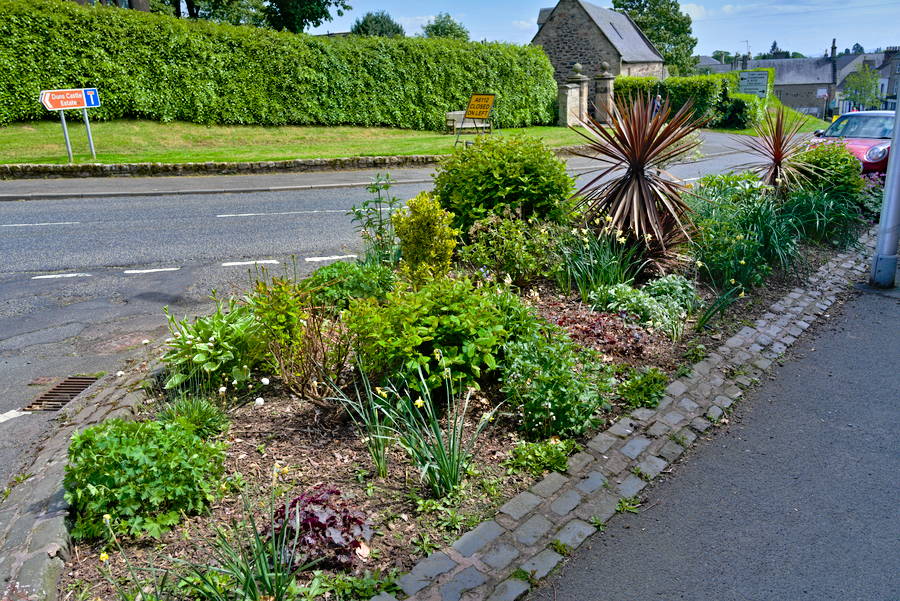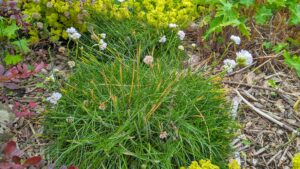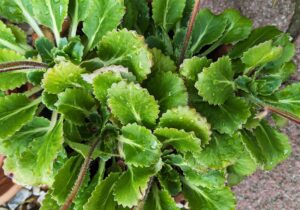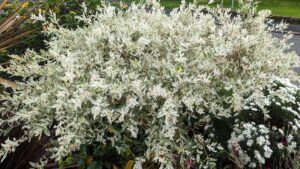
 |
Robust and Reliable --- Thrifts also known as Armeria maritima or Sea Pink. | Armeria grow in low tufty mounds so you need to look down to spot them. They are evergreen plants that form rounded tufts of narrow strappy leaves and round heads of rich pink or bright white flowers on long stalks. --- Did you know? Armeria are really tough little plants. They can cope well with dry conditions and are great for rock gardens. You will often see them at the coast as they can tolerate salty sea breezes, hence the name ‘maritima’. |
 |
Robust and Reliable --- Geranium Rozanne PBR (AGM) also known as Cranesbill | Geranium Rozanne PBR (AGM) just keeps on blooming! From early summer to mid Autumn you will be able to spot Geranium ‘Rozanne’. Look for big mounds of saucer shaped violet blue flowers with white centres. This lovely plant thrives in sun or shade and is really loved by pollinators. --- Did you know? Geranium Rozanne was the winner of the Royal Horticultural Society Plant of the Centenary in 2013. The letters PBR stand for plant breeders rights. This denotes the intellectual property of a plant. |
 |
Robust and Reliable --- Geranium macrorrhizum also known as Bigroot or Bigfoot geranium or Balkan Cranesbill. | Geranium macrorrhizum has mounds of beautiful fragrant light green leaves. It flushes with clusters of small saucer shaped pink flowers much loved by bees. It is a really useful plant for dry shady areas and the leaves are great for hiding the dying foliage of bulbs in the Spring. --- Did you know? It is sometimes called ‘Bigroot’ because it has the thickest most tuberous root of any geranium. The big fat roots, also called rhizomes, store water so that it does not dry out in the Summer. |
 |
Robust and Reliable --- London Pride also known as Saxifrage, St Patrick’s Cabbage and Look up and Kiss Me. | London Pride spreads to form a low carpet of thick green rosette shaped foliage. It can grow in shade and sends up delicate tall sprays of tiny white star shaped flowers in late Spring and early Summer. It is a really easy plant to grow as long as it has a reliable source of water. --- Did you know?....One explanation for the name ‘London’s Pride’ is that it is such a tough plant that it thrived on the barren bomb sites left after the London Blitz. |
 |
Fabulous Fragrance --- Salvia | Salvia come in many different forms, colours and heights. They often have really aromatic leaves when rubbed. This fragrance defends the plant from deer and rabbits. You will be able to spot the small red flowers of our Salvias right through until the first frosts. Some Salvias really don’t like to get too wet or cold in the winter. --- Did you know? Some Salvias have really fun names…look out for ‘Hot Lips’ or ‘Kisses and Wishes’ or ‘Cherry Lips’! When you see the dainty flowers shapes you will see why! |
 |
Wildlife Welcomers --- Cerinthe also known as Honeywort | Cerinthe. The clue is in the common name…bees just love Cerinthe and it flowers all summer. Look out for low lying clumps of eye catching blue-green leaves edging the beds. Cerinthe flowers are quite unusual… tubular bell shaped yellow and purple flowers peeking out below deep purple bracts. (Bracts are leaf like structures that sit around the flower head). --- Did you know? Cerinthe is really easy to grow from seed and will also self- seed prolifically. |
 |
Fantastic Foliage --- Salix ‘Hakuro-nishiki’ (AGM) also known as Flamingo Willow | Salix ‘Hakuro - nishiki (AGM). This is a little willow tree. In the Spring you will easily spot its flamingo like leaves, white and green with pink tips. In the Autumn the leaves will have dropped but the stems will be a lovely coral colour. --- Did you know? Salix ‘Hakuro-nishiki ‘has a Royal Horticultural Society award for Garden Merit. |
 |
Seasonal Showstopper --- Hypericum also known as St John’s Wort | Hypericum are really tough reliable shrubs that are easy to grow. In 2022 we chose our Hypericums from a series called ‘Magical’ because the yellow and orange berries matched the Duns 2022 Rievers colours of yellow and orange! In early summer look out for masses of bright yellow flowers. As the flowers shed in later summer you will spot the lovely glossy berries. Hypericum berries are really long lasting and show bright colour into late Autumn.The berries should not be eaten. --- Did you know? The name St John’s Wort apparently refers to John the Baptist as the plant is in full bloom in late June at the time of the feast of St John. It was been traditionally used in medicine as far back as the Ancient Greeks. |
 |
Seasonal Showstopper --- Penstemon | Penstemon. Look for upright clumps of bushy, narrow pointed leaves. The flowers at the tips look like little thimbles. Penstemon plants come in many colours including white, pink, red, blue and purple and sometime even combine two colours. This is known as bi-colour. Penstemon love full sunshine. --- Did you know? Penstemon do not like very cold wet soil and sometimes will not survive harsh wet winters. |
 |
Seasonal Showstopper --- Iris also known as Bearded Iris or Iris germanica | Iris are some of the earliest flowers to bloom in the garden. They hold their remarkable flowers high in the air on long straight stems. In May and June look out for large frilled flowers. They have unusual thick bushy beards that look like little caterpillars on the lower petals. Iris are easy to grow and make a stunning display. --- Did you know? The Iris is the fleur-de-lis symbol that represented French royalty. Some Iris can be really long living and flourishing for up to 30 years. After flowering Iris have to rest in late summer and soak up the sunshine to prepare to flower again. |
 |
Seasonal Showstopper --- Lychnis coronaria also knows as Rose Campion, Mountain Pink | Lychnis coronaria. Lychnis grows in many shades of white, pink and purple with green or grey leaves. Look out in the Clouds bed in Summer for distinctive clusters of very silvery grey stems and leaves with dainty deep magenta flowers in shades of pink. --- Did you know? Lychnis coronaria has a Royal Horticultural Society award for Garden Merit (AGM). Pollinating insects love Lychnis coronaria too. |
 |
Beautiful Bulbs --- Tulips also known as Tulipa | Tulips. In the Springtime you will enjoy our selection of multi-coloured tulips. They are grown from bulbs, and once planted, most Tulips will return year after year and gradually spread. This spreading is called ‘naturalising’. You will spot the Tulips with their broad strappy green leaves, straight stems and cup like flowers. Tulips also grow well in pots. ---Did you know? Many people think that Tulips originate from Holland. In fact they were first imported to Holland from the Ottoman Empire (now Turkey) in the 16th Century. |
 |
Beautiful Bulbs --- Daffodils also known as Narcissus | Daffodils have slim green leaves and straight slim stems topped by bright trumpet shaped flowers, usually orange, white or yellow surrounded by six petals. Also grown from bulbs, they will return and keep spreading. They are also happy to be grown in pots. --- Did you know? Daffodil bulbs are poisonous but are easily mistaken for onions so never plant them in vegetable plots. |
Head back down the slight hill to the main road. Turn right at The Horn pub. Walk past the Police Station. Cross over at the pedestrian crossing to reach the two Potentilla Patch beds.
Disclaimer
Our plants are grown for ornamental purposes only. We do not advise touching or ingesting any parts of the plants on the Duns Flowerbed Trail. Many plants can be an irritant or toxic when smelt, ingested or touched. All the ‘Did you know?’ information about alternative plant use is provided for educational interest only.
